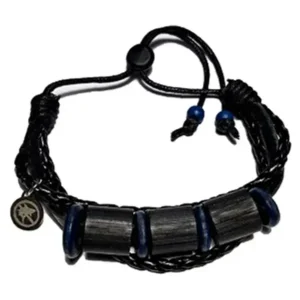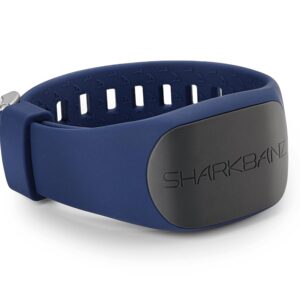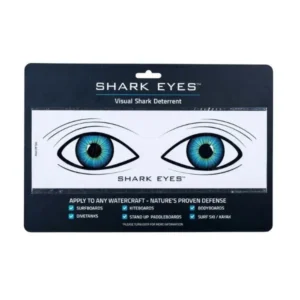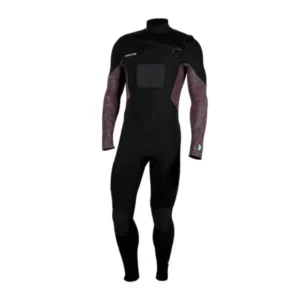Ahoy, sea adventurers! Today, we’re diving deep into the thrilling world of shark repellents – those nifty contraptions and quirky ideas claiming to be our underwater guardian angels. The ocean, is vast and mysterious, with its share of finned wonders. As our fascination with the deep blue grows, so does the need for a shark-friendly handshake, and that’s where these deterrents step into the limelight.
But hold onto your swim fins because it’s not just about keeping sharks at arm’s length; it’s about exploring the uncharted waters of innovation. From eye stickers that play tricks on a shark’s perception to electric fields that promise a shockingly good time, the options are as intriguing as the ocean depths.
So, buckle up your life jackets, folks! We’re about to embark on a journey through the realms of science, scepticism, and a touch of the unexpected. Join us as we unravel the mysteries of shark deterrents and separate the sea-worthy solutions from the fishy fables. It’s time to crack the code and make some waves in the world of underwater safety!
The Science Behind Shark Repellents
Let’s break down the science behind shark repellents in a way that’s easier to chew on. You’ve got these cool devices trying to outsmart sharks, and the key is disrupting their finely tuned-senses.
Some use electric fields to give sharks a kind of underwater jolt, making them rethink coming closer. Then there are visual disruptors, like those eye stickers – basically, it’s like giving sharks a quirky makeover to keep them at bay. Chemical repellents create an underwater environment that sharks find off-putting. Annoying sounds and magnetic fields also come into play to mess with their groove.
According to the National Institute of Health (NIH), While some products are capable of affecting the behaviour of sharks and can reduce the risk of a shark bite, others do not have the advertised outcome. So, scientists are still figuring out which of these tricks are like kryptonites for sharks. It’s a bit like trying to outsmart the ocean’s top predators, and the science is still making waves!
Shark Repellents on the Market
Eye Stickers
Shark Eyes stickers are designed based on the principle of visual disruption. They slap these stickers on things like surfboards, making them look like they have giant, predatory eyes. The idea is to tap into the sharks’ natural fear of bigger predators. So, when they see these “eyes,” they think, “Whoa, maybe I should give this thing a pass.” It’s like a sneaky way to use their own instincts against them.
Chemical Repellents
They are like creating a shark-free zone by using certain chemicals, often with copper in the mix. The idea is to make the environment so uncool for sharks that they’d rather swim away. They might coat boat bottoms or diving gear with these chemicals.
Magnetic Repellents
Magnetic repellents are cool gadgets that aim to mess with sharks’ internal compass. The idea is to create magnetic fields that make certain areas less appealing to our finned friends. It’s like giving sharks a navigational headache, so they think twice about hanging around. Studies say it might work, but it depends on the type of magnetic field and the shark species.
Electronic repellents
They work by throwing out electrical or magnetic fields that mess with how sharks pick up signals in the water. It’s like giving them a little underwater static. The hope is that sharks find it annoying or confusing enough to steer clear.
Navigating the Pros and Cons of Various Repellents
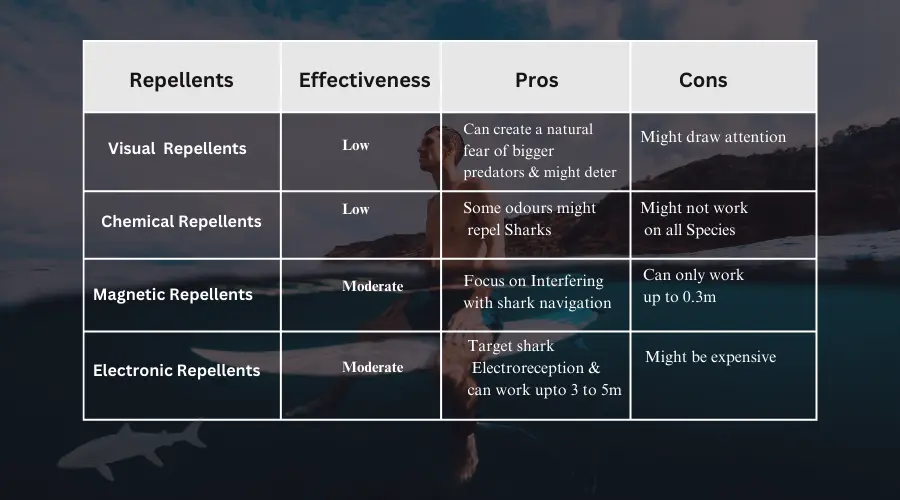
Why Choose SharkOff?
While the effectiveness of shark deterrents can vary and is subject to ongoing research, one option that’s been getting some nods in the research game is the “SharkOff” and its electric field magic. These devices create an electrical field around the user, aiming to deter sharks by emitting a low-frequency, pulsed electrical field.
- Aesthetic Appeal: Designed to be inconspicuous, ensuring it doesn’t interfere with your style or water activities.
- Affordable: Provides an effective shark deterrent at a budget-friendly price point.
- 1.5 Volt Power: Operates on a common and easily accessible 1.5-volt power source.
- Ease of Use: Designed for simplicity, making it easy to incorporate into your water activities.
- Reusable: Crafted with reusability in mind, offering both cost-effectiveness and environmental consciousness.
- Humane: Their rare earth metals (not magnetic) hydrolyze (dissolve in water and release hydrogen atoms) to create the electrical field that repels sharks. Their patented active element is strong enough to make the shark jerk away without harming them.

Now, studies say they might do the trick, but here’s the catch: it’s a bit like playing a guessing game. The effectiveness depends on the specific device, the environment, and the type of shark you’re dealing with. These electronic gizmos are kind of like the cool gadgets in the shark deterrence scene, but not everyone’s fully convinced they’re the superhero cape we’re looking for.
Safety guidelines to reduce the risk of shark encounters
- Stay Informed: Be aware of local shark activity and follow warnings from authorities.
- Deterrent Awareness: If using shark deterrents, follow guidelines and stay informed about their effectiveness.
- Follow Local Rules: Adhere to posted signs and regulations for water safety and shark activity.
- Fish School Distance: Avoid swimming near schools of fish, which may attract sharks.
- Kelp Awareness: Exercise caution in shallow water with kelp, where wobbegong sharks may hide.
- Buddy Up: Always engage in water activities with companions to avoid attracting sharks.
- Clear Waters, Clear View: Stay away from murky water to enhance visibility and spot sharks more easily.
- Timing Matters: Avoid water activities during dawn, dusk, or night when sharks are more active.
- River Mouth Caution: Steer clear of river mouths, especially after rain, as sharks may be present.
- Pet-Free Zone: Skip swimming with pets to avoid attracting sharks.
Conclusion
So, imagine you’re in the vast ocean, and just thinking about sharks gliding beneath the waves can give anyone the creeps. Enter shark repellents – a bunch claiming to be your underwater guardians. But, sharks are mysterious, responding to different things. If you’re eyeing a repellent, make sure it’s backed by solid research.
Even with the best repellent, you might become its first real-life test subject. Sharks rule the ocean, playing by their own rules.
Here’s the truth – no repellent guarantees 100% shark-proof. If you’re just catching waves for the thrill, save your dollars or stick to the sandy shores. But, if you’re a diver or first responder, these tools might be your ticket to self-preservation.
Choose wisely, keep your wits, and remember, no repellent guarantees 100% effectiveness. So, if you’re thinking about giving these a go, keep your shark senses sharp, follow the guidelines, stay updated on the latest research, and it’s never a bad idea to get some advice from the pros. Safety first when you’re out there in the big blue!





